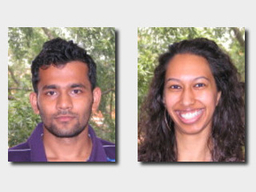Graduate Student Seminar
Location
Engineering : 027
Date & Time
October 17, 2018, 11:00 am – 12:00 pm
Description
| Session Chair: | Michael Lucagbo |
| Discussant: | Dr. Thomas Mathew |
Speaker 1: Abhishek Guin
- Title
- How many times do you shuffle a deck of cards until it is random?
- Abstract
- The analysis of random processes is a familiar duty in life (“How long does it take to get to the airport during rush-hour?”) as well as in mathematics. Of course, getting meaningful answers to such problems heavily depends on formulating meaningful questions. For the card shuffling problem, this means that we have to specify the size of the deck (n = 52 cards, say), to say how we shuffle (we analyze top-in-at-random shuffles first, and then the more realistic and effective riffle shuffles), and finally to explain what we mean by “is random” or “is close to random" (which we will quantify by variation distance). The precise answer is 7 for a deck of 52 cards. Fewer are not enough and more do not significantly improve the mixing. This surprising result, when discovered, made the *New York Times* in 1990.
The finding has implications for everyone who plays cards and everyone, from casino operators to magicians, who has a stake in knowing whether a shuffle is random. Our goal here would be an analysis of the riffle shuffle, due to the statistician David Aldous and the former magician turned mathematician Persi Diaconis. We will not reach the final precise result that 7 riffle shuffles are sufficient to get a deck of 52 cards very close to random, while 6 riffle shuffles do not suffice — but we will obtain an upper bound of 12, and we will see some extremely beautiful ideas on the way.
In the end, everything will be reduced to two very classical combinatorial problems, namely the coupon collector and the birthday paradox.
Speaker 2: Janita Patwardhan
- Title
- Oligarchy in the Islet: Hub Cell Desynchronization
- Abstract
- Characterized by elevated blood sugar levels, diabetes jeopardizes the health of millions of people worldwide. Our body's cells absorb glucose as a primary source of energy with the assistance of the hormone insulin secreted from pancreatic β cells, resulting in lower blood sugar levels. In non-diabetic patients, insulin secretion is oscillatory, implying a synchronization of β cell activity within the islet. Unfortunately, this synchronous behavior is often lost in diabetic patients. It has recently been shown experimentally that silencing more functionally connected hub cells within the islet can disrupt the synchrony of β cell activity. This brings into question the previously accepted democratic paradigm of insulin secretion with more evenly weighted input from each β cell.
We have begun to test this hub desynchronization hypothesis using network analysis on a hexagonal-close-packed-lattice with a model representing the electrical and calcium dynamics of β cells during insulin secretion. Utilizing methods from graph theory on a network constructed from functional connectivity, we have replicated the power law distribution for the number of functional connections per β cell that was observed experimentally. The few cells with the highest quantity of functional connections, labelled as the hub cells, were silenced to determine their impact on islet activity.
While a highly gap junctionally connected islet did not satisfy the hub desynchronization hypothesis, we have been able to computationally replicate the reduction of synchronous behavior using a more sparsely connected islet. This work was initiated as part of the NSF-REU (#1460652) with Elise Falgout, Destiny Frett, Lorenzo Neil, and Ryan Schumm.
Tags:
